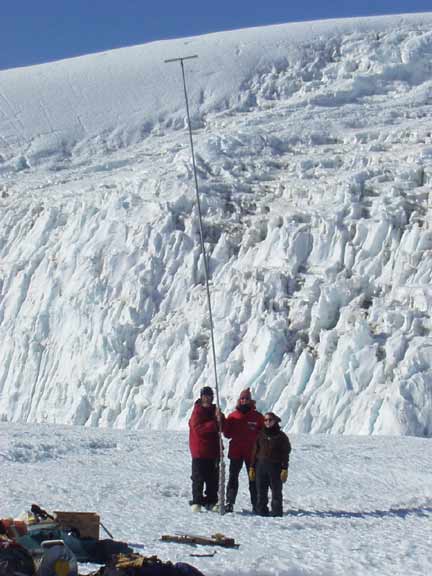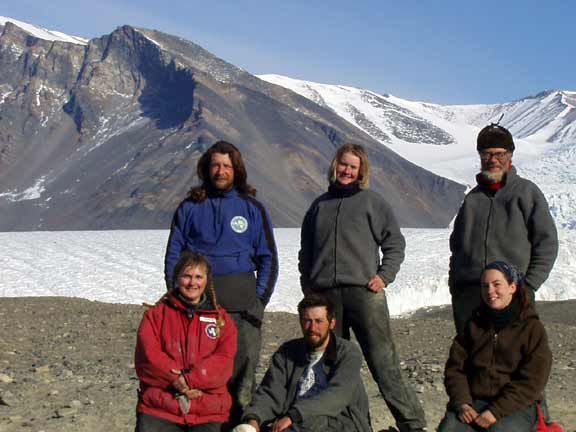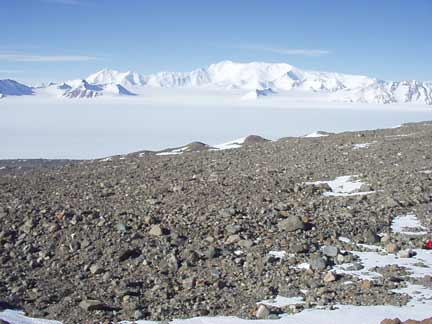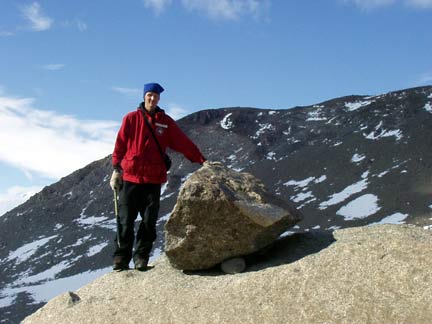Fluctuations of Dry Valleys Lakes, Antarctica
Fluctuations of Dry Valleys Lakes, Antarctica
Brenda Hall, Thomas Whittaker, Katie Faloon and Alex Roy, University of Maine
John Stone, Howard Conway and Maurice Conway, University of Washington
December 15, 2003 to February 10, 2003






The lakes in the Dry Valleys are closed basin lakes. That is, they have no present outlet to the sea. The water levels of these lakes record the hydrologic variations, which are related to regional climate. Our past work here has shown that at times the lakes are as much as 400m deeper than they are now. To obtain a continuous water-level record, we are spending our second of two field seasons in the Dry Valleys taking sediment cores from the lake bottoms.
This field season we will begin ourfieldwork at Lake Vanda in Wright Valley. The lake is 70m deep at its deepest, and as such represents our biggest coring challenge this season. After completing operations at Lake Vanda we will put together a schedule to try and visit some or all of the the other lakes highlighted in the figure.
Tom Whittakar sums up the season:
I have now returned to the rather less adventurous aspect of our work, that which takes place in the office workspace back in Orono. But rather than being sad about trading the limitless magnificence of the Dry Valleys for the Geology Building here at UMaine I’m looking forward to getting my hands dirty sifting through the results of a phenomenal field season.
We made a good team, Brenda, Chris, Erica, Katie, Alex and I. Our individual strengths combined well to complete virtually any task we set ourselves, and also to cope with any difficulties that cropped up along the way. With various in-jokes, stories, slapstick comedy, and unfathomable inanities we were able make the most tedious of tasks that little bit more lighthearted.
This season we conducted research at Lakes Vanda and Brownworth (Wright Valley), Vida (Victoria Valley) Joyce (Pearse Valley), and Bonney (Taylor Valley), as well as at numerous ponds located in amongst the hummocky, boulder-strewn terrain of the Dry Valleys. Brenda and Katie made several hikes in Taylor Valley and Wright Valley searching for algae in old shorelines and deltas deposited higher up on the valley walls.
In the midst of all this we also made two day-trips north to the Convoy Range, the location of several other small ‘dry’ valleys. Here we investigated whether or not these valleys may have contained large proglacial lakes in the past, similar to those that formed in Taylor, Wright and Victoria Valleys. (Proglacial is a term that in its literal sense means ‘something directly in front of glacier ice’. So the lake I describe is one that is bordered on one side by an ice margin.)
We had many goals for the season, not the least of which from my point of view, included Lake Frywell sediments that will constitute the basis for my Master’s thesis. We were able to accomplish a great deal in the short time we had at each field site, and made a significant number of extra discoveries at Lake Frywell. All in all we had a very successful season.
Cheerio
Wednesday December 17, 2003
Tom reports from Christchurch:
We made it out of Bangor through a snowstorm on Monday morning. Someone later told me that we were on the last flight out that day. We had a very bumpy ride down to Boston, but all of the flights after that were a piece of cake. We used our five hour lay-over in Los Angeles to take a cab to Venice Beach. While there we paddled in the Pacific, and then watched the sun set over the ocean.
Everybody slept well on the flight down to Auckland, and as a result we’re all feeling quite rested. We did though get a big surprise at Christchurch when we met the Raytheon representative. Turned out that we would be heading South a day earlier than anticipated. So we went and got our clothes at the CDC, and then used what was left of the day to find a place to eat and to get to know our Kiwi colleague, Erica, who’d also flown down from the North Island that day. We didn’t even have time to see The Lord of The Rings! Unless we boomerang today, we’ll have to wait until February to see the movie.
So now, less than 24 hours after we arrived in Christchurch, we are all sweating to death in our ECW gear waiting to board a Kiwi Herc to McMurdo. The loadmaster reckoned a flight time of 7 hours. Fingers crossed all goes well!
Thursday December18, 2003
Alex writes from McMurdo:
We made it! Yes after a whirlwind ride from Maine we have arrived safely here in McMurdo Station, a bit worn out but glad to be on the Ice nonetheless. Katie,Tom, Erica and myself are doing well and settling in here on base.
We are scheduled for a logistics meeting tomorrow morning (19th) and I will also be contacting Brenda via Iridium Phone to let her know we have arrived early. Tom and I are scheduled for our field refresher course on Sat, so we should be able to do some work and get most of the gear together this weekend. The girls have their snow-school on Mon-Tues so there is a chance we may all be able to go out in the field together. If things move the way they have been so far (very fast) I foresee us in the field before Xmas. Brenda had the opportunity to arrange most of the gear, leaving us only a few things to get together (Radios, Coring Equipment, ect.).
The weather here in Mac-Town is a balmy 38 degrees, with no wind, and a lot of melt runoff. If this nice weather holds we should have a fantastic field season, but again this is Antarctica, and that is something you can never count on.
Monday December 22, 2003
Tom writes from McMurdo:
Today we esentially had a day off. Nobody works on Sundays, and we pretty much have everything sorted (except the coring gear that isn’t here). So we braved some driving snow to do a little shopping over at Scott Base a mile and a half down the road. Tomorrow Katie and Erica will go off to snow school, and will go through two days of Antarctic survival training. I have scheduled them on a flight out to Lake Vanda on Tuesday afternoon so they’ll have to miss the last part of the training. Alex and I will also have a busy day tomorrow. We need to get all of our gear down to the helo pad including our core boxes and half pipes that are currently being manufactured and were promised to be ready by 10am tomorrow. We also need to test our radios, collect the water testing gear from the Crary Lab, and find out what happened to our coring equipment! Fingers crossed it is here and has everything we need!!!So, if we get to go tomorrow, we’ll be away from any computers until we leave the field in early February. Merry Christmas and Happy New Year from us all!
Tom
Wednesday December 24, 2003
Katie writes from McMurdo:
Monday morning while Alex and Tom prepared to fly out, Erica and I left for a fun two days in snowschool. We first learned about frostbite, hypothermia, and the survival bags packed in every vehicle, and then traveled with our group of 10 out to Snow Mound City. Snow Mound City is the place where every snow school goes to build survival shelters in the snow. It’s located on an ice sheet about 2.5 miles away from Mac-Town. It was a gorgeous day – Mt. Erebus was in plain view with a plume of smoke rising from the top. We learned how to build a quinzhee, which is a hollow snow dome similar to an igloo, a wind-break wall made of snow blocks, and also how to set up Scott tents and other tents using snow to insulate them. We learned to use the small gas stoves given in survival bags and had to make dinner by melting snow for water. Around dinner time the Snow-school instructor left us to fend for ourselves in our newly constructed shelters. He slept about a mile away in a nice warm hut. It wasn’t bad sleeping in our shelters though, it was a very sunny night and quite warm.
The next morning we learned how to operate the radios we will be using in the field. As a test of our knowledge we made a radio call to the South Pole, who wished us a very Merry Christmas. Then we came back to McMurdo to watch a video on proper helicopter protocol. The weather was pretty cold and it had been snowing steadily since about 10 a.m., so at this point we were informed that our scheduled flight had been indefinitely postponed. That day was the last fly day before Christmas, so we will be staying here until the 26th. We were quite disappointed at not being able to join Alex and Tom, but since we’re here for Christmas we will be able to participate in Christmas Dinner (which I hear serves lobster, steak, and roast duck!) and hopefully get in touch with our families. Erica and I have both come down with The Crud, the Mac-Town name for the common cold, so having two more days to rest up indoors will be good for us. We have just found out that we will be flying out at 8:30 on Friday morning. Hopefully the weather is good so we can join Alex and Tom in the field!
Merry Christmas and best wishes from all of us!
- Team holding the SIPRE auger. Joyce Sipre – To drill through the lake ice, we use a hand-powered SIPRE auger. Lake Joyce was particularly tricky, the ice being almost 7 m thick.
- This is an example of one of our sediment cores from Lake Vanda. White layers are gypsum and carbonate and indicate times of lower lake level.
- End of season photo of the field team (back, l to r), Alex Roy, Erica Hofstee, Chris Hendy, (front) Brenda Hall, Tom Whittaker, Katie Faloon.
- View over the till sheet deposited during the last glaciation by Reedy Glacier (background) in the Quartz Hills.
- Gordon with a perched boulder deposited during the last glaciation.







